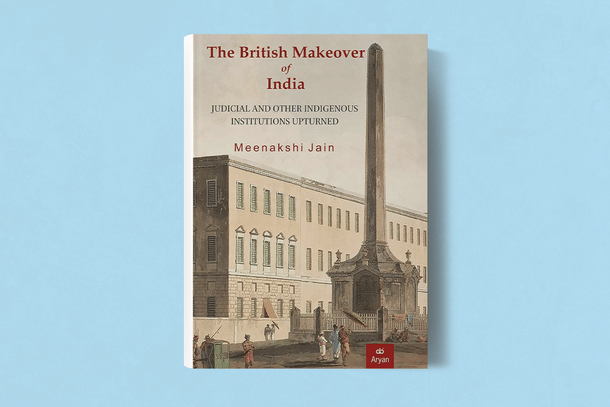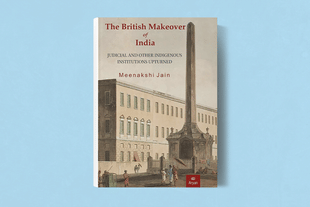Books
Book Details How Brits Went From Admiration To Disdain Of The India They Ruled
R Jagannathan
Jun 25, 2024, 12:39 PM | Updated Aug 29, 2024, 01:05 PM IST
Save & read from anywhere!
Bookmark stories for easy access on any device or the Swarajya app.


The British Makeover of India: Judicial and Other Indigenous Institutions Upturned. Meenakshi Jain. Aryan Books. 2024. Pages 299. Price Rs 995.
Power changes perceptions. What view one holds on someone else depends to a large extent on whether you are in a position of dominance, where you have the power to judge, even misjudge, the subservient other.
Once the power equation changes in your favour, your views change. You no longer have to be indulgent or accommodative.
The Prophet of Islam, in his initial preachings in Mecca, was tolerant and accepting of other people’s faiths and beliefs. Once he consolidated power after fleeing to Medina, his Islam became less tolerant of dissent and disallowed deviations.
We see this playing out all through history. In India, British writers associated with the East India Company in the eighteenth century saw HIndus/Indians and their age-old institutions quite differently from how their successors in the nineteenth century — when British power had grown absolute — saw their subjects.
If the first lot admired the resilience of Hindu/Indian institutions despite centuries of Islamic rule, the second lot saw Hindus and their religion as decrepit, degenerate and deserving of demise.
This has been amply demonstrated in The British Makeover of India: Judicial and Other Institutions Upturned, which is historian Meenakshi Jain’s latest book.
Jain has authored excellent books on the connections of Rama, Krishna and Shiva to Ayodhya, Mathura and Kashi respectively (Rama and Ayodhya, Vasudeva Krishna of Mathura, and Vishwanath Rise and Rises).
The British Makeover documents in detail how the eighteenth century adulation for Hindus/Hinduism changed to disgust and dislike in the next century, as the British consolidated power.
From traders they became revenue collectors and administrators before finally becoming absolute rulers of pre-Independence India.
The early phase of colonialism, where trading and revenue interests dominated thinking in the East India Company, involved not only acceptance of indigenous institutions, but also developing some degree of admiration for it, due to its longevity.
Even the evangelists, though not willing to concede the validity of Hindu and Indian religions and practices, were keen to understand local traditions and scriptures with a view to ultimately converting the heathens. Some of these eighteenth century officials “found indigenous institutions in the realms of redress and education in a surprisingly good state”, notes Jain.
Dharampal, in his book The Beautiful Tree, documents how traditional education in the early nineteenth century was probably superior to what England had at that time. Jain focuses more on how the indigenous judicial redressal system seemed to be settling disputes and delivering faster justice at almost no cost to litigants.
The early British writers and administrators who were sympathetic to local institutions included Luke Crafton, John Holwell, Alexander Dow, Robert Orme and Harry Verelst.
They were supported by British administrators (Warren Hastings, the first Governor General of India, 1772-1785), and conservative thinkers in England such as Edmund Burke, who noted the antiquity and endurance of Indian laws. These laws had little to do with Roman or British jurisprudence.
This benign consensus, to let the locals run with local laws, subject only to the limitation that these cannot negatively impact colonial revenues and political interests. They were joined by the early Orientalists like William Jones, one of the earliest admirers of Indic civilisation and Sanskrit.
But this started changing as British power kept rising, and intellectuals like James Mill and Charles Grant (to be followed later by J B Macaulay), saw Hindu customs and traditions as unworthy. These needed to be replaced with learnings from the European Enlightenment, scientific progress and British modernity.
It was from this stage in the mid-nineteenth century and later that British ideas started imposing themselves on India — largely to the detriment of Indians. It may not always have been the result of bad intent, but the attempt to view the Indian situation with Eurocentric lenses did immense damage.
Jain mentions how Warren Hastings, despite a broad commitment to let indigenous institutions be, tried to codify Hindu law by selecting 11 pundits to draw up a common Hindu code called the Vivadernavasetu.
These codes were drawn from the Dharmashastras, even though in actual practice local tradition and laws over-rode what these holy texts contained.
In a chapter titled “British-Crafted Indigenous Texts”, the author notes how Hastings and his group “committed grievous errors in trying to implement what they believed were native laws. They resolved that canonical Dharmashastras, not customary law, would be the source and foundation for judicial decisions.”
They failed to see that Hindu laws did not emanate from one set of accepted scriptural texts, just as other administrators decided that the varna system was how Hindu society organised itself, and various jatis (usually endogamous social groups) were often force-fitted into the four varnas without their consent. In reality, jatis were far more flexible and mobile than what the scriptures indicated.
The damage done to Hindu law and practices by Islamic rulers in the centuries before British rule was compounded by the British when they tried to bring in the British system of jurisprudence to India. The negative assumptions about Hindu practices were aided by missionaries who, anyway, had a vested interest in denigrating local faiths and traditions.
The British Makeover is one of Jain’s best works, and we have more to look forward to as it will have a second volume following it.
The first volume has 19 chapters, and the key ones include ones which deal with the observations of the early writers who saw some merit in indigenous institutions (chapter 2), and the effort to create a British-mediated Hindu code (chapters 5 and 6).
These efforts plunged British India headlong down a “perilous path”. The pre-1772 judicial system (chapter 7) and the indigenous system of justice (ie, the panchayat system, chapter 13), are particularly informative.
Chapters 14, 15 and 16 deal with the Darogah system (which was the British instrument of control), the police system and ground reports on the British-formulated justice system — which didn’t work as well, and which we are still paying a price for.
Bringing up the rear are chapters 18 and 19 which deal with the growing influence of missionaries, and how the country effectively came to be ruled by strangers with no love lost for the land they ruled. Emblematic of this rule of strangers was James Mill’s History of British India, which makes no pretence of its disdain for India and things Indian, and marked the turning point in British attitudes towards its subjects.
Jain’s book offers a wonderful insight into how a colonial power begins with respect for indigenous institutions, and then, as it grows in confidence in its own powers, decides to impose its worldview, occasionally with the best of intentions, but often with a racist mindset and superiority complex.
It's a pity how colonised Hindu minds, including some in the judiciary, even today are inheritors of the nineteenth century British mindset instead of being true Bharatiyas.
The book is easy to read, extensively referenced, and does not stray into ideological speculation and needless extrapolation. One cannot wait for Jain to give us the second instalment of her work on the British makeover, which deals with early East India Company officials’ evaluations of the indigenous education apparatus.
Jagannathan is former Editorial Director, Swarajya. He tweets at @TheJaggi.





